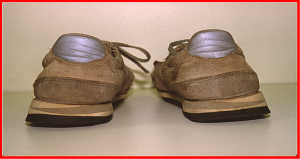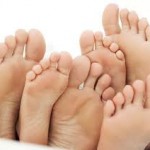 Your feet are your foundation. They function to support body weight during stance and to propel the body forward during gait. There are 26 bones in each foot and 206 total bones in the human body. Thus, your feet account for 25% of the bones in your body! An average person takes between 5000 and 7000 steps per day and this increases for people who are more active.
Your feet are your foundation. They function to support body weight during stance and to propel the body forward during gait. There are 26 bones in each foot and 206 total bones in the human body. Thus, your feet account for 25% of the bones in your body! An average person takes between 5000 and 7000 steps per day and this increases for people who are more active.
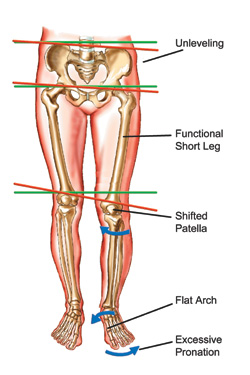 You don’t need to have foot pain to have a foot problem. Typically, unaddressed mechanical problems of the feet exist for a period of time before causing symptoms. Sometimes mechanical issues only become apparent after a change or increase in one’s activity level or an increase in body weight (due to added stress and resulting pain). In addition, a mechanical or alignment problem at the feet can alter mechanics and position of joints higher up in the kinetic chain including ankles, knees, hips, the back and even the neck! Thus, foot posture is related to one’s whole body posture and a mechanical foot issue can cause or contribute to pain in other areas of the body. Uncorrected, postural imbalance and uneven joint wear can accelerate joint degeneration (arthritis).
You don’t need to have foot pain to have a foot problem. Typically, unaddressed mechanical problems of the feet exist for a period of time before causing symptoms. Sometimes mechanical issues only become apparent after a change or increase in one’s activity level or an increase in body weight (due to added stress and resulting pain). In addition, a mechanical or alignment problem at the feet can alter mechanics and position of joints higher up in the kinetic chain including ankles, knees, hips, the back and even the neck! Thus, foot posture is related to one’s whole body posture and a mechanical foot issue can cause or contribute to pain in other areas of the body. Uncorrected, postural imbalance and uneven joint wear can accelerate joint degeneration (arthritis).
1) Choose appropriate footwear:
The unfortunate trend is people choosing fashion over function, however, footwear with poor support and fit is frequently the cause or contributor of musculoskeletal foot disorders. Womens’ high heeled shoes are the worst culprit forcing excessive weight distribution at the ball of the foot and inward deviation of the toes. When choosing footwear…
a) choose flats or a slight heal over high heeled shoes
b) ensure correct fit
The toe box should not put excessive pressure on the sides, top or front of feet. A good tip when buying shoes is to take the insole out and place your foot on it – your footprint shouldn’t go over the edges of the insole for correct fit. Another tip is to shop for shoes at the end of the day as your footprint will be slightly larger from the day’s stresses.
c) for adequate motion control and support, shoes should pass 4 tests (shown below)
Dish Rag Test: if the shoe twists easily, it fails the test
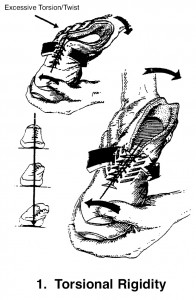 Pinch Test:if the heel counter is soft, it fails the test
Pinch Test:if the heel counter is soft, it fails the test
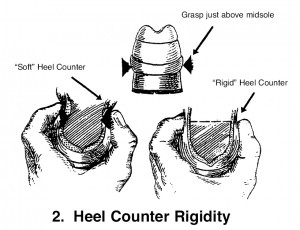 Fold Test: the shoe should bend easily where the toes naturally bend only
Fold Test: the shoe should bend easily where the toes naturally bend only
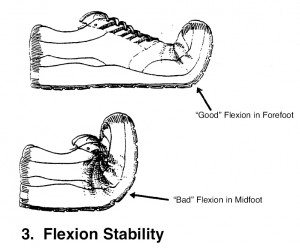 Shelf Test: there shouldn’t be any drifting of the shelf relative to the heel when viewing shoes end on; there shouldn’t be excess ‘give’ when you push the shelf side to side.
Shelf Test: there shouldn’t be any drifting of the shelf relative to the heel when viewing shoes end on; there shouldn’t be excess ‘give’ when you push the shelf side to side.
Running shoes should be replaced at a minimum of yearly but even sooner (every 3-6 months) for runners or the overweight as shoe structure breaks down faster.
3) Weight loss if overweight:
Being overweight will result in more load on all joints of the body but especially the feet because they support the whole body. As a result, obese people tend to have flattened arches more often than the general public. Muscles must also work harder to support excessive weight. The added force of weight also exacerbates any mechanical or alignment problems.
4) Do exercises for feet and calves:
Appropriate stretching and strengthening of the lower extremity muscles can be greatly beneficial. Tight, shortened muscles should to stretched and weaker, lengthened muscles should be strengthened. By doing so, muscles become more balanced which adds mechanical balance to related joints. A chiropractor can give you more specifics related to your particular case. For example, stretching the the calves is particularly helpful for those with plantar fasciitis (a painful inflammation and scarring of the plantar fasciia which results in heel and arch pain that is worst with the first morning steps). Rolling your foot forward and back over a tennis ball is also great, massaging and improving circulation. There are also specific exercises for those with flat feet which help to strengthen and support the longitudinal arch of the foot.
5) Have a gait scan:
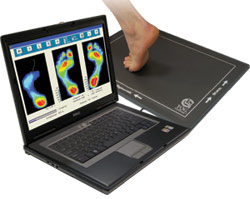 Having a gait scan involves walking barefoot across a pressure sensitive mat. A computer records data and generates an image of where you put pressure on your feet when you walk. This is compared to the normal foot. A gait scan (along with a chiropractic analysis) helps to determine need for orthotics. Data from the scan can be used to create custom-made orthotics which will reduce abnormal foot function while walking and realign your feet to a more normal position. As many as 60-70% of people have some sort of abnormal foot function and can benefit from a custom orthotics prescription. The cost of foot orthotics is covered by most extended healthcare and insurance plans. Some insurance plans require a referral from your medical doctor first. Check with your policy for the specifics of your coverage.
Having a gait scan involves walking barefoot across a pressure sensitive mat. A computer records data and generates an image of where you put pressure on your feet when you walk. This is compared to the normal foot. A gait scan (along with a chiropractic analysis) helps to determine need for orthotics. Data from the scan can be used to create custom-made orthotics which will reduce abnormal foot function while walking and realign your feet to a more normal position. As many as 60-70% of people have some sort of abnormal foot function and can benefit from a custom orthotics prescription. The cost of foot orthotics is covered by most extended healthcare and insurance plans. Some insurance plans require a referral from your medical doctor first. Check with your policy for the specifics of your coverage.
6) Have a chiropractic analysis:
Chiropractors are skilled at assessing posture, alignment and function of the neuromusculoskeletal system. As mentioned earlier, foot position relates to whole body posture. Thus if you have a foot problem, a full spinal analysis is beneficial as well. Chiropractic adjustments to the spine help normalize overall mechanics and also reinforce response to orthotic prescription. Chiropractic can assess bones in feet and determine if a particular joint is restricted. If a joint is restricted then it means that other joints must compensate – this can lead to pain. Adjustments help correct this.
7) Other:
Other tips for healthy feet include regular cardiovascular exercise and a healthy, balanced diet as these are beneficial for overall health and healing. It is also important to maintain good foot hygiene including keeping toenails neatly trimmed. Inspect feet for any unusual changes in appearance.
Dr. Elisabeth Miron
Looking for custom foot orthotics in Aurora? Visit Dr. Miron’s chiropractic website.
